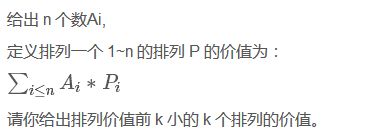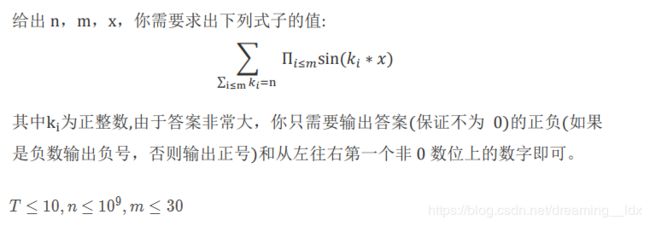雅礼集训2019 Day1
three
bzoj原题
就是一道 d p dp dp状态很妙的长链剖分优化 d p dp dp。
permutation
毒瘤题。

n , k ≤ 1 e 5 n,k\le1e5 n,k≤1e5
考试的时候只写了 k ≤ 2 k\le2 k≤2的部分分。
下来直接 O r z Orz Orz题解了。
勉强看懂大概是这样的。
首先显然可以将 A A A升序排序,然后当 P P P数组降序排列的时候显然是最小的(排序不等式)
然后现在我们将问题转化为 P P P数组不动,只改变 A A A数组的顺序。
现在我们用类似求 k k k短路的方法,从最小值开始拓展,每次取当前最优解再次拓展一直到前 k k k大都取完。
我们如果要将一个排列变成另一个价值稍微大一点的排列,最优情况相当于对一个区间进行一次循环右移操作,代价是 ∑ i = l r A r − A i \sum_{i=l}^{r}A_r-A_i ∑i=lrAr−Ai。
我们记 ( p o s , l e n ) (pos,len) (pos,len)表示一次将区间 [ p o s − l e n + 1 , p o s ] [pos-len+1,pos] [pos−len+1,pos]这段区间进行一次循环右移, g ( p o s , l e n ) g(pos,len) g(pos,len)表示其代价,显然有 g ( p o s , l e n ) ≤ g ( p o s , l e n + 1 ) g(pos,len)\le g(pos,len+1) g(pos,len)≤g(pos,len+1),我们只需要对每个还未确定的 p o s pos pos维护其 g ( p o s , l e n ) g(pos,len) g(pos,len)这个属性。
然后有两种新的扩展:
- 执行完 ( p o s , l e n ) (pos,len) (pos,len)之后的新扩展,这会产生一个新的A序列,此时所有的剩下未固定位置len全部重新设为1,计算delta。
- 将 p o s pos pos位置的 l e n len len修改为 l e n + 1 len+1 len+1,并且计算新的 g ( p o s , l e n ) g(pos,len) g(pos,len) 。
于是可以用可持久化线段树来维护。
代码比较有技巧性(貌似可以可持久化 t r e a p treap treap博主咕掉了)
代码:
#includemath

高考与 O I OI OI的结合?
首先看出这题是一个划分问题可以用 d p dp dp搞(然而之前考试写背包+ f f t fft fft优化爆精度了233333)
我们定义将 n n n个划分成 m m m个的总贡献为 f ( n , m ) f(n,m) f(n,m)。
由于代价的计算是一种诡异的形式,因此我们只用看以下两种划分的转移。
- m m m个中有一个 k i k_i ki是 1 1 1,则 s i n ( x ) ∗ f ( n − 1 , m − 1 ) → f ( n , m ) sin(x)*f(n-1,m-1)\rightarrow f(n,m) sin(x)∗f(n−1,m−1)→f(n,m)
- 没有一个 k i k_i ki是 1 1 1,那么考虑对之前某一个 k i k_i ki加上一求出贡献,后面会乘一坨奇奇怪怪的系数,我们来算一下。
当前这个新的 k i ki ki的贡献是 s i n ( k x ) sin(kx) sin(kx)
由于 s i n ( k x ) = s i n ( ( k − 1 ) x ) c o s ( x ) + c o s ( ( k − 1 ) x ) s i n ( x ) sin(kx)=sin((k-1)x)cos(x)+cos((k-1)x)sin(x) sin(kx)=sin((k−1)x)cos(x)+cos((k−1)x)sin(x),注意到前面的 s i n ( ( k − 1 ) x ) sin((k-1)x) sin((k−1)x)对应了 f ( n − 1 , m ) f(n-1,m) f(n−1,m),因此只需要把后面那一坨转成可以与 f ( t , m ) f(t,m) f(t,m)对应的形式即可。
我们继续做三角函数恒等变形:
= s i n ( ( k − 1 ) x ) c o s ( x ) + s i n ( x ) c o s ( x ) c o s ( ( k − 2 ) x ) − s i n 2 ( x ) s i n ( ( k − 2 ) x ) =sin((k-1)x)cos(x)+sin(x)cos(x)cos((k-2)x)-sin^2(x)sin((k-2)x) =sin((k−1)x)cos(x)+sin(x)cos(x)cos((k−2)x)−sin2(x)sin((k−2)x)
= s i n ( ( k − 1 ) x ) c o s ( x ) + s i n ( x ) c o s ( x ) c o s ( ( k − 2 ) x ) + ( c o s 2 ( x ) − 1 ) s i n ( ( k − 2 ) x ) =sin((k-1)x)cos(x)+sin(x)cos(x)cos((k-2)x)+(cos^2(x)-1)sin((k-2)x) =sin((k−1)x)cos(x)+sin(x)cos(x)cos((k−2)x)+(cos2(x)−1)sin((k−2)x)
= s i n ( ( k − 1 ) x ) c o s ( x ) + c o s ( x ) ( s i n ( x ) c o s ( ( k − 2 ) x ) + c o s ( x ) s i n ( ( k − 2 ) x ) ) − s i n ( ( k − 2 ) x ) =sin((k-1)x)cos(x)+cos(x)(sin(x)cos((k-2)x)+cos(x)sin((k-2)x))-sin((k-2)x) =sin((k−1)x)cos(x)+cos(x)(sin(x)cos((k−2)x)+cos(x)sin((k−2)x))−sin((k−2)x)
= s i n ( ( k − 1 ) x ) c o s ( x ) + c o s ( x ) s i n ( ( k − 1 ) x ) + c o s ( x ) s i n ( ( k − 2 ) x ) ) − s i n ( ( k − 2 ) x ) =sin((k-1)x)cos(x)+cos(x)sin((k-1)x)+cos(x)sin((k-2)x))-sin((k-2)x) =sin((k−1)x)cos(x)+cos(x)sin((k−1)x)+cos(x)sin((k−2)x))−sin((k−2)x)
= 2 c o s ( x ) s i n ( ( k − 1 ) x ) − s i n ( ( k − 2 ) x ) =2cos(x)sin((k-1)x)-sin((k-2)x) =2cos(x)sin((k−1)x)−sin((k−2)x)
这样相当于对应了一种转移: 2 c o s ( x ) ∗ f ( n − 1 , m ) − f ( n − 2 , m ) → f ( n , m ) 2cos(x)*f(n-1,m)-f(n-2,m)\rightarrow f(n,m) 2cos(x)∗f(n−1,m)−f(n−2,m)→f(n,m)
于是 f ( n , m ) = s i n ( x ) ∗ f ( n − 1 , m − 1 ) + 2 c o s ( x ) ∗ f ( n − 1 , m ) − f ( n − 2 , m ) f(n,m)=sin(x)*f(n-1,m-1)+2cos(x)*f(n-1,m)-f(n-2,m) f(n,m)=sin(x)∗f(n−1,m−1)+2cos(x)∗f(n−1,m)−f(n−2,m)
可以矩阵快速幂优化。
代码:
#include